The non-qualified mortgage market has experienced significant growth since its introduction nearly a decade ago. 10 years in, credit ratings agencies regularly release performance metrics for investors, which provide remarkable insight into this extremely versatile asset class.
In a recent default study on non-QM performance over the years, for example, KBRA analysts note that non-QM loans faced tremendous macroeconomic uncertainties, from the recent era of high interest rates to the COVID-19 lockdowns, and yet continue to perform above and beyond expectations.
Why is non-QM earning its place at the mortgage dinner table?
Let’s examine the current landscape of borrowers in the market and explore why Non-QM loans are proving to be such an attractive option for them. Generally speaking, we’re observing a diverse group of individuals and businesses seeking financing solutions that traditional mortgage products may not accommodate. This includes self-employed individuals with fluctuating incomes, real estate investors with multiple properties, and those who may have experienced a past credit event but have since re-established financial stability.
The appeal of Non-QM loans stems from their inherent flexibility. Unlike Qualified Mortgages, which adhere to strict DTI (debt-to-income) ratios and income verification methods, Non-QM loans offer alternative documentation options. For example, a self-employed borrower might use bank statements to demonstrate income, rather than relying on traditional tax returns that might not entirely reflect their accurate financial picture. Investors can benefit from debt service coverage ratio (DSCR) loans, where the property’s rental income is a key factor in qualifying, rather than their personal income. This adaptability allows lenders to assess risk based on a more holistic view of the borrower’s financial capacity and the specific nature of their investment or income stream.
Furthermore, Non-QM products can cater to those with unique credit profiles or those who may not fit the conventional “prime” borrower mold. This doesn’t necessarily imply higher risk, but rather a different risk assessment framework. For many, Non-QM represents a vital pathway to homeownership or real estate investment that would otherwise be inaccessible, fostering financial inclusion and supporting a broader segment of the market.
The emergence of influencers and the broader gig economy has fundamentally reshaped our understanding of traditional income sources. In this evolving landscape, individuals are increasingly less reliant on conventional employment models that offer fixed salaries and long-term contracts. Instead, a significant portion of the workforce, particularly younger generations, is turning to alternative, more flexible income-generating avenues. This shift necessitates a new approach to financial strategy, one that acknowledges and actively capitalizes on these diverse and often unconventional streams of revenue.
Cash flow analysis has become the cornerstone of income determination in the modern financial landscape. The world has evolved, and with it, the traditional notions of income have expanded to include a plethora of non-traditional forms. For example, consider the burgeoning gig economy: income is no longer solely derived from a consistent salary, but can originate from diverse sources such as ride-sharing services like Uber, freelance work, or short-term contract assignments.
These alternative income streams necessitate a more nuanced approach to financial assessment, moving beyond conventional income verification methods to a more dynamic and comprehensive evaluation of an individual’s overall cash flow. This allows lenders and financial institutions to accurately gauge a borrower’s ability to repay, even if their income doesn’t fit the rigid molds of the past.
Our core customer base is comprised of individuals seeking non-QM products. With a decade of market performance data, we can confidently state that these loans have consistently demonstrated strong performance. While I don’t have the exact comparative figures readily available, our internal analysis and historical trends clearly show that this paper has performed robustly, often rivaling or even exceeding the stability of conventional mortgage products. This sustained performance over a significant period underscores the viability and reliability of the non-QM market, providing confidence to both lenders and borrowers alike.
Lower interest rates are unequivocally beneficial for our business operations and we look forward to the widely anticipated September cut from the Federal Reserve. After all, there’s no room for doubt that a decrease in rates will stimulate growth. Specifically, it will revitalize the refinance market, allowing more homeowners to adjust their existing loans to more favorable terms.
Furthermore, as rates decline, we anticipate attracting a significantly larger pool of potential borrowers. This is primarily because lower interest rates translate directly into reduced monthly payments on the interest side of their mortgages, making homeownership more accessible and affordable. While we acknowledge the persistent challenges related to property taxes and insurance costs, those issues fall under a separate purview. They are distinct from the positive impact of declining interest rates on our core lending activities.
My advice to LOs is to keep cultivating and nurturing new relationships within the real estate sphere. Moreover, there is tremendous value in maintaining strong connections with realtors who prove to be steadfast friends and colleagues, regardless of market conditions. These efforts will go a long way toward expanding your network and developing your existing business, not just today, but also well into the future.
In parallel, we are actively engaging with our broker community on the wholesale side of our operations. Our experts in this area can provide detailed insights into the specific communication strategies and diverse channels we utilize to foster these crucial relationships and drive new wholesale business.
Marc Halpern is the Chief Executive Officer of Foundation Mortgage.
This column does not necessarily reflect the opinion of HousingWire’s editorial department and its owners. To contact the editor responsible for this piece: zeb@hwmedia.com.



